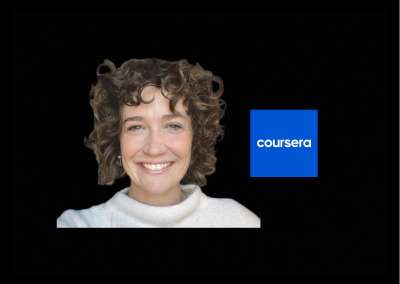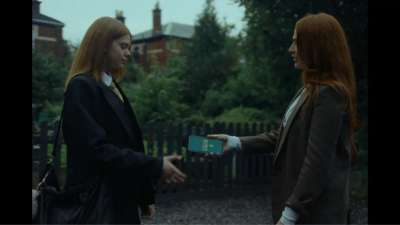Advertisers Watching Ads - Episode 182
Everyone gets a phone as a teenager. How do they deal with it? What's this process like for the teens? And what about the parents?
EE has correctly capitalised on the parental anxiety when it comes to teenagers using smartphones in their ad produced by Saatchi & Saatchi, "Safer Sims." The campaign chosen for us by Contagious goes beyond the memorable and emotional TV ad. There is a big 360 production, but you have to dig deep to find the connected resources. And when you look closer, there are some interesting contradictions in how the brand is perceived, too.
Watch the latest episode to see how our guests discuss its creative effectiveness, hearing from marketing leaders Sarah Du Plessis (Senior Brand Manager at Perfetti Van Melle), Izzy Tepekoylu (VP of Growth at Zopa Bank), and Steven Seddon (CMO at Ice Travel Group).
Transcript
This is automatically generated, so it’s not 100% accurate.
Tom Ollerton 0:00
Hello and welcome to Advertisers Watching Ads. This is a show where brands watch other brands’ ads.
Sarah Du Plessis 0:06
For me, my biggest frustration was, so what is a safer sim? Like how on earth does this work?
Steve Seddon 0:11
Time will tell, right? Is this the start of a positioning? Is it the start of a strategy?
Izzy Tepekoylu 0:15
You know, you can't have that comment out there when you're trying to do this thing.
Tom Ollerton 0:19
My name is Tom Ollerton. I'm the founder of Automated Creative, the creative effectiveness adtech platform. And before we see this week's ad, let's meet this week's guests.
Sarah Du Plessis 0:34
Hi, everyone. I'm Sarah, Senior Brand Manager for Mentos UK at Perfetti Van Melle, which is a big confectionery company.
Izzy Tepekoylu 0:41
Hi, everyone. This is Izzy Tepekoylu. I'm VP of Growth at Zopa Bank.
Steve Seddon 0:45
I'm Steve, I'm the CMO of Ice Travel Group, which is IceLolly and TravelSupermarket.com.
Tom Ollerton 0:50
So we've got travel, confectionery and fintech. So this is going to be obviously brilliant. But what we're seeing today is an ad for the EE’s “First Day,” it’s an emotional film. Talking about safer sims for kids created by Saatchi & Saatchi, directed by Daniel Wolfe, and talking about the parents’ mix of pride and anxiety and EE hopefully offering a bit of reassurance.
Tom Ollerton 2:01
Right, now, I need you guys to score this ad. One, two, three... A four, four, and four. What else do you gotta do? Oh, brilliant! So, Sarah, that it seems to be the lead bit of content. But what else is going on in this campaign?
Sarah Du Plessis 2:30
EE positions itself, or like their brand positioning is all centred around being that family centric approach in terms of telecommunications. I've got a toddler, so I'm just really not in this life stage at the moment. But you know, there is a big conversation happening in the office often at the moment around what is the right age to give the phone and how do you prepare them for it? How do you prepare for it?
Steve Seddon 2:53
It is close to my heart. I've got an 11 year old and a 14 year old. In fact, the 11 year old is just sort of got her first phone because she goes into year six. Everyone gets a phone. It felt spot on, really, apart from the fact the, the kid seemed a little bit old for me. Other than that, it felt really authentic.
Izzy Tepekoylu 3:11
If I wear my CMO hat, this nails the TV brief. Strong emotional insights like I feel as a parent: should I give the phone? I want to give the phone. I want to help him. But like, I'm worried. This like, leans into this anxiety. It's very clearly targeted for parents. Great track choice. 1996. Beautiful casting, visually clean. I love the whole thing, but like the storytelling is a bit, a bit cheesy, you know, like, oh, there's all this anxiety, doom scroll and then you put the sim and everything is unicorns and sunshine. So that does kind of feels a bit flat on my, on my head.
Sarah Du Plessis 3:47
It's a big 360 campaign from what I understand. It's been supportive of out of home, it’s been supported by radio and also social. Yet when you try and actually search for it, it’s very hard other than the TV ads to find any examples, it feels like a little bit like a stand alone campaign. I don't feel it's as integrated as it should be. Definitely.
Steve Seddon 4:07
To give EE the benefit of the doubt there, I think it, it sort of introduces the concept and the positioning and the strategy of, of what they want to be and the family at the heart of things. And I think it's, it's like a really bold statement to me. It's easy to leave this and let other people pick up the conversation. From my perspective, I think arguably the conversation should be picked up by Meta, by Google, by the government, by people like that. If you're, you know, providing phones in a way EE are, you can easily say, “I'll leave this conversation for somebody else.” Time will tell, right? Is this the start of a positioning? Is it the start of a strategy?
Izzy Tepekoylu 4:45
I feel like, I think, some, a bit humility in the end would have helped make it more genuine and kind of hit the heart a bit more like something along the lines of, we can't solve all your problems, but this thing can help.
Tom Ollerton 4:59
One thing that's really great about this is that they've created a new category of products here. A sim’s a sim as sim, like, I don’t know, like a virtual sim, but like a sim is... it's just that little thing, right? You just put it in your phone but they're like safer sim. Two words have invented a brand new category. As far as I'm aware, I didn’t know that was... There might be millions of them, but I have no idea. But like, so what they've actually done is depositioned to everyone else as just a sim while their sim is a safer sim, and they’ve done that in two words, which is genius. So actually the campaign could be absolutely toilet and it would still work because they've created a category of one.
Sarah Du Plessis 5:33
For me, my biggest frustration was so what is a safer sim? Like, how on earth does this work? And I was a bit like, this is very cryptic and I know I guess that's part of some of the great advertising that you then go away and do your research elsewhere. I mean, I then went on to learn that there's three versions of SIM cards and you can actually do a digital kind of transformative journey with your teenager, and you can let the boundaries go down stage after stage. They’ve not only created a category, they've actually created subcategories with different levels of restrictions and scope. You know, I love the fact that if you ran out of data, it'll still let you use the Uber app to get home. It will let you use Google Maps. It will still let you use WhatsApp and not send pictures. So you know all of those moments when you know your kids got stranded or forgotten where they're meant to be or how to get home, they should hopefully be able to navigate life still if they've got their phone. So I learnt a lot when I went on to do that, but none of that comes through.
Izzy Tepekoylu 6:29
Even on the landing page. What's a safer sim? How does it work? Those are the features that I learned from you now.
Tom Ollerton 6:35
Absolutely. The other thing that I think they're missing is and you see this quite a lot on this show, when brands put themselves in a purpose place, you've got to do more than an ad. But what they haven't followed up with is like, right, okay, we are going to produce regular content on a monthly basis, a podcast, an event, a series, we're gonna visit schools. We're going to be the champion of kids safety on phones. If they were a movement and movements, movements are repeatable. And you know, as opposed to like, hey, hey, we've got this cool thing, off you go.
Steve Seddon 7:04
From what I've read that they are doing that in schools. They have people in stores, they're setting up the website. They don't have to start this conversation and they, and they have. So I think it's easy to look through the lens of a marketer and think we as marketers should be doing more. The reality is that a viewer watching this is cynical about advertising, right? And they'll see the advert and they'll be like, “Hang on a minute, aren’t you just supposed to be selling phones? But here you're telling me that there's an issue with phones.” And I think that, that at least creates a pause in people's thinking and starts a conversation. And I think that's what great advertising does. It starts the conversation. Whether this is like a cynical way to sell sims or the start of creating some sort of sense of responsibility for how we're leaving teens to deal with society will remain to be seen.
Izzy Tepekoylu 7:55
I genuinely believe, like EE is trying to do that, I'm sure. Of course, they're a corporation, they'll try to sell phones. They're trying to get market share, margins, blah, blah, blah... But in the meantime, they're also trying to do some good with this thing. And I was looking at again on social, there is one post about this topic, on their Facebook page. And right underneath the comment is, “But EE will still cold call your minor repeatedly, even during school hours, trying to pressure them to discuss new offers with their clearly labelled child family account on their parent's account.” Like there's these things that as a big brand, as the market leader, as the 800-pound gorilla, you have to be really agile, you know, you can’t have that comment out there when you're trying to do this thing.
Sarah Du Plessis 8:38
If you think of big brands, one of the most robust ways of checking kind of brand health tracking in the UK is through Kantar brand health studies, you know, the measures they use for brand salience are memorable, meaningful and different. This really does move in that direction. If you think around kind of other phone providers. I'm not sure many people would know exactly what they're doing. So I think it's really interesting that there are a few of these kind of providers, you know, stepping out or just trying to sell phones and, you know, trying to educate and help support and drive awareness in another way. For sure.
Tom Ollerton 9:17
Would you sign off the whole campaign in its current form, on a count of three, thumbs up or thumbs down, one, two, three... And for any of you guys watching this on YouTube or LinkedIn, please put your score in the comments below. I want to see what you guys think as well. That’d be brilliant. All right, we'll see you all next week.
What next?
Subscribe to our YouTube channel
Listen to our ‘Shiny New Object’ Podcast on Apple Podcasts, Spotify and Soundcloud.
Want to stay updated with the latest industry news?
Subscribe to our newsletter
and we will keep you posted.

EE iPhone 12 Ad Reviewed
25.11.2020Watch Adidas, GSK and Renault review EE's bonkers Rita Ora and Kevin Bacon ad.

AI Agents & Data That Answers the Right Questions - with Coursera's Emily Keller-Logan
26.06.2025Emily Keller-Logan shares the secrets to employing AI agents to improve marketing effectiveness, and how curiosity and matching data to relevant business questions can enhance your data driven marketing.

Emirates Airlines Ad Reviewed
25.08.2021The latest ad from Emirates Airlines, On Top of the World, reviewed by guests from the7stars and Groupe Renault. We review the marketing strategy behind this clip and discuss its impact on audiences.
